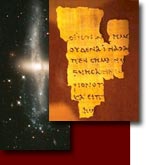| Site Map | Contacts | Links | Newsletter | |
The Bible:
Pseudepigrapha
Pseudepigrapha is the transliteration of the Greek plural noun that means "with false superscription" (Charlesworth 1983, xxv). This refers to a collection of some 65 writings that are falsely attributed to an important Bible (OT) character. Most of the Pseudepigrapha writings were written between 200 BC and 200 AD by Jews or Christians.
The best reference for the Pseudepigrapha with notes and translations is The Old Testament Pseudepigrapha edited by James H. Charlesworth, published by Doubleday, Volume 1, 1983, and Volume 2, 1985.
The Old Testament Pseudepigrapha can be divided into five genres: Apocalyptic literature, Testaments, Expansions of OT, Wisdom literature, and Psalms, prayers, or odes.
Apocalyptic Literature (19)
- Enoch (Ethiopic Apocalypse of Enoch)
The Book of Enoch contains vivid descriptions of Enoch’s journeys through the universe. There are 10 heavens that one must pass through to where God dwells. He also tours earth and Sheol (Hell). Fragments of I Enoch have been found among the Dead Sea Scrolls. - Enoch (Slavonic Apocalypse of Enoch)
- Enoch (Hebrew Apocalypse of Enoch)
- Baruch (an Apocrypha book)
- Baruch (Syriac Apocalypse of Baruch)
- Baruch (Greek Apocalypse of Baruch)
The 3 (Greek Apocalypse of) Baruch tells about Baruch, the scribe of Jeremiah who weeps over the destruction of Jerusalem. God sends an angel to comfort and guide him through the heavens. Five heavens are graphically described, but there were probably a total of seven heavens because the work is incomplete, and Origen states that Baruch refers to seven heavens (Origen 1936, 91; Charlesworth 1983, 653). - Sibylline Oracles
The Sibylline Oracles predict future woes and calamities that will happen on earth; however they were written down after the events. It is a collection of oracles from early Jewish (2nd century BC) to late Christian writers (7th century AD). - 4 Ezra
- Greek Apocalypse of Ezra
- Vision of Ezra
- Questions of Ezra
- Revelation of Ezra
- Treatise of Shem
- Apocryphon of Ezekiel
- Apocalypse of Abraham
- Apocalypse of Adam
- Apocalypse of Daniel
- Apocalypse of Elijah
- Apocalypse of Zephaniah
Expansions of the Old Testament
- The Letter of Aristeas
The oldest and most important translation of the Hebrew Old Testament (OT) is the Septuagint (LXX). It translated the Hebrew into Greek in the third century BC in Alexandria, Egypt. The Letter to Aristide tells the story how the Egyptian king Ptolemy II (285-247 BC.) ordered his librarian, Demetrius to collect all the books of the world. Demetrius thought there should be a Greek translation of the Torah so 72 Jews, six from each tribe are sent to translate the Torah into Greek which they did in 72 days (Charlesworth 1985, 7-34). - Book of Jubilees
The Book of Jubilees is the supposed account of events from creation to Moses. Chapter two tells of the six day creation of the world. Events are dated according to their jubilee year. The book defends the 364 day calendar year which assures that festivals fall on the same day of the year. The Qumran Community (DSS) also used a 364 day calendar. The date of this book is about 100 BC (Charlesworth 1985, 35-142). - Martyrdom and Ascension of Isaiah
- Life of Adam and Eve
- Ladder of Jacob
- Joseph and Asenath
- History of Joseph
- Jannes and Jambres
- History of the Rechabites
- Eldad and Modad
- 4 Baruch
- Lives of the Prophets
- Pseudo-Philo
Testaments
- Testaments of the 12 Patriarchs
- Testaments of Adam
- Testaments of Job
- Testaments of Abraham
- Testaments of Isaac
- Testaments of Jacob
- Testaments of Moses
- Testaments of Solomon
Wisdom Literature
- Ahiqar
An Ayrian writing from about 600 BC. This writing is important for understanding early Jewish thought. - 3 Maccabees
- 4 Maccabees
- Sentences of Syriac Menander
Psalms, Prayers, and Odes
- Other psalms of David
- Psalms of Solomon
- Odes of Solomon
- Prayer of Jacob
- Prayer of Joseph
- Prayer of Manasseh (included in the Apocrypha)
- Hellenistic Synagogal Prayers
